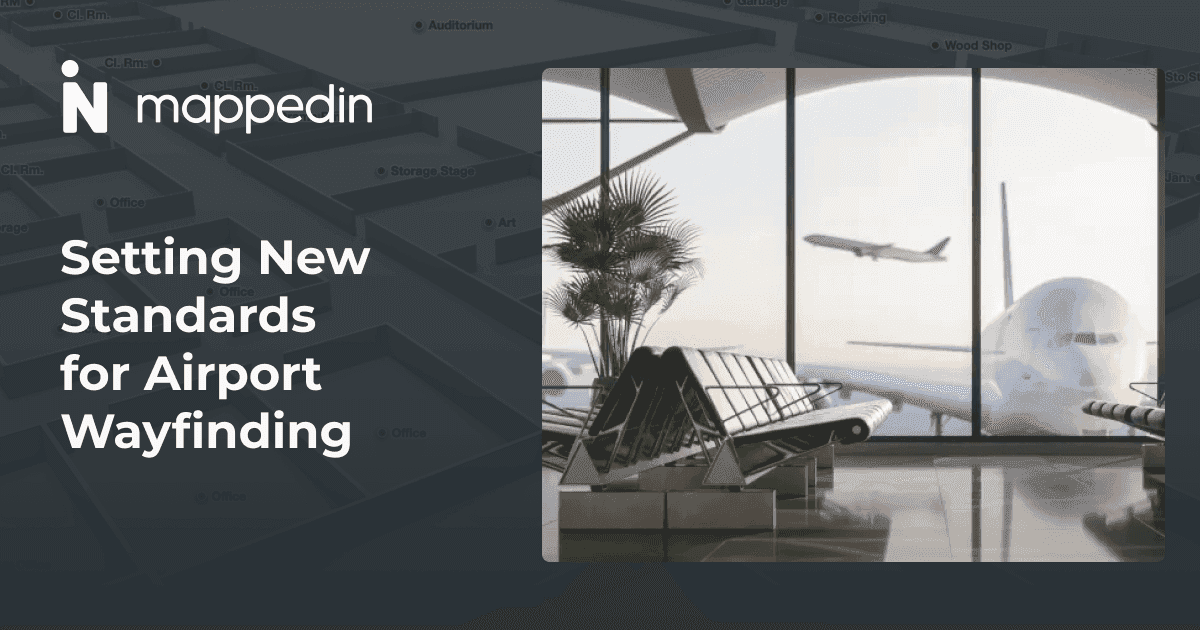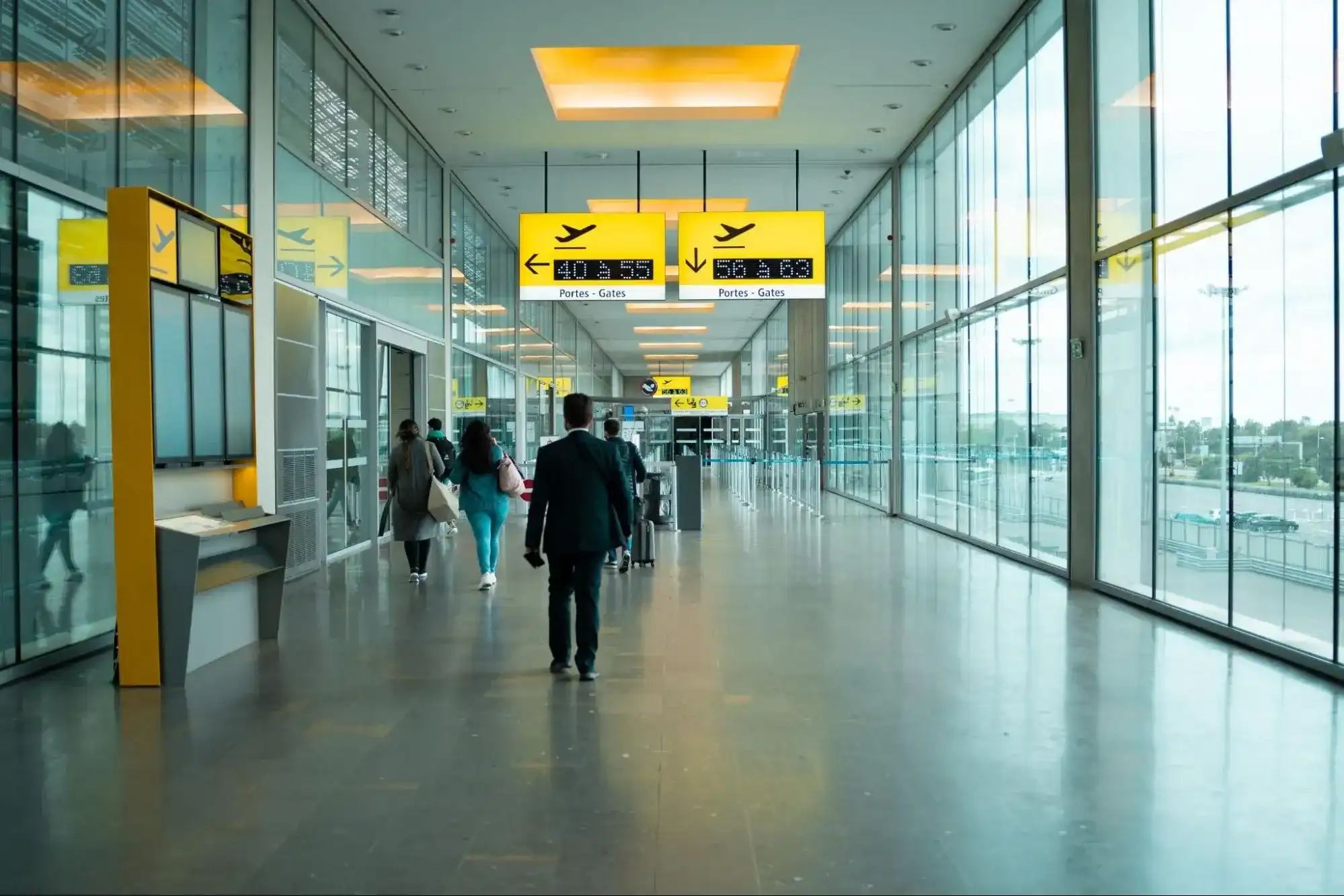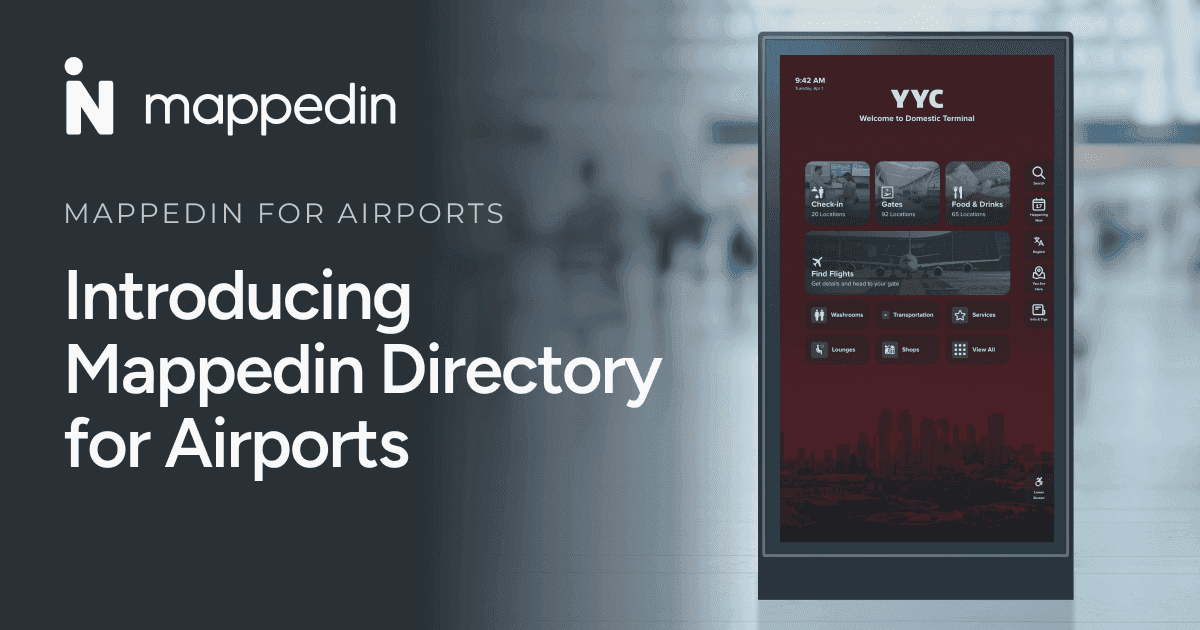Start Here
Indoor mapping in airports enhances passenger experience by providing real-time navigation to gates, terminals, and services, displaying flight information updates including delays and gate changes, offering accessibility features such as prioritized ramps and elevators and multilingual support, facilitating parking and shuttle services through digital booking systems, displaying security wait times, and implementing marketing through digital directories and location-based promotions that increase non-aeronautical revenue while improving passenger engagement.
Whether you’re going on a holiday vacation, or simply visiting a friend or family member in another country, an airport is your first stop along the way. With indoor mapping technology, airports can drastically improve your travel experience and make preparing for your flight enjoyable and stress-free. Let’s explore how.

Find your gate and terminal
Rushing to catch your flight? We’ve all been there. Navigating a large airport can be confusing and stressful, but with indoor navigation systems, passengers and employees can get step-by-step directions from their exact location to any destination in real-time. This ensures that you can swiftly locate the right terminal and boarding gate for your flight, along with ticketing counters, airport security, restrooms, restaurants, baggage claim, and all other services in the airport. If you’re looking for a specific item, such as a travel pillow, you can search for this on the map, and receive a list of shops that sell travel pillows, along with detailed information on operating hours and deals and promotions.
You can also plan your trip ahead of time by using indoor maps to determine the amount of time it takes to get to security checkpoints, your boarding gate, and all other airport checkpoints. Indoor mapping calculates the fastest route to your destination, so no time will be spent wandering around the airport. With this in mind, you won't have to worry about missing your scheduled flight!
Travel information on-the-go
Along with wayfinding and navigation, airports can provide passengers with up-to-date information regarding flight numbers and schedules. From flight delays and layovers to gate changes and cancellations, airports can keep passengers informed by displaying real-time information on the map. This digital map can be accessed throughout the airport on digital directory displays, through QR codes on printed materials, or on a mobile application. For instance, with a mobile app, updates and directions can be accessed on-the-go through your mobile phone. Similarly, digital directories can be placed at airport gates, so that passengers can get flight updates while they wait to board the plane. With travel information available at your fingertips, keeping track of flight changes becomes simple and stress-free.

Inclusive travel experience
With accessible and attainable indoor mapping, airports can promote an inclusive environment that accommodates both domestic and international travellers. Mappedin creates maps with accessibility guidelines in mind, offering different languages and RTL text support to serve travellers all around the world. With Accessibility Mode turned on, individuals with accessibility needs, such as families with strollers and individuals bound to wheelchairs, can populate routes that prioritize ramps and elevators over stairs. Even more, indoor navigation systems can operate with voice commands or written instructions for those who are visually or hearing impaired. These features ensure that maps are attainable, so that everyone can refer to them for information and navigation.
Parking and shuttle services
Accessing parking and shuttle services are one of the many use cases of indoor positioning at airports. Finding a parking spot when you arrive at the airport can be a challenge, but with indoor positioning, travellers can visualize and access available parking on the digital map. When integrated with smart technology, you can simply pull up the map, locate the nearest parking to your terminal, and click on an available parking spot to book it. This ensures a seamless and hassle-free experience from the moment you park your car, to the second you arrive at your boarding gate.
In addition to guided parking, indoor maps help you locate and access shuttle services. Upon arrival at an unfamiliar airport, passengers can utilize the digital mapping tool to lead them directly to their shuttle bus, train, or car. This ensures a seamless connection from the airport to your hotel, drastically improving your travel experience.
Baggage claim
Waiting for your baggage after a long flight is tiring and time consuming. With unpredictable wait times, baggage claim can take up valuable time that could be spent grabbing food at a restaurant or picking up necessities at a duty-free shop. Instead of making passengers wait at baggage claim, airports can use indoor positioning systems to notify passengers when their baggage has arrived. Even more, these notifications can direct them to the conveyor belt in which their luggage will arrive. This way, passengers can explore the airport and find their way back to baggage claim with ease.

Emergency aid
As a busy transportation hub, airports can also benefit from indoor mapping to enhance safety procedures and emergency aid. With the ability to showcase different map views and routes based on different users, an emergency personnel map can indicate the location of individuals seeking help and areas where they keep safety equipment. This way emergency personnel can monitor, locate, and visualize incidents on a map in real-time. Meanwhile, a visitor map can enable travellers to request help and report incidents directly on the map. This notifies emergency personnel of their exact position and ensures that individuals get the help they need quickly and efficiently.
Advertising and proximity marketing
Another use case for indoor mapping in a transportation hub such as an airport is advertising and proximity marketing. Digital directories can be implemented across the airport in key locations, such as gate entrances, and can be used to display advertisements. With passengers using directories for directions, it is an optimal location to drive attention to ads, while creating an additional stream of income for your airport. In addition, there is great potential for proximity marketing in airports.
With indoor positioning at airports, you can drive foot traffic to stores and restaurants by sending push-notifications of ongoing deals and promotions. For instance, while passing by a duty-free store, a passenger can be notified that beauty and cosmetics are 20% off. Alternatively, proximity marketing can drive sales of specialty services such as seat upgrades and first-class services. Not only does this increase revenue for airports, but it highlights amenities and discounts that passengers wouldn’t have been aware of otherwise.
To learn more about our solutions for airports and transportation hubs, or how you can create an enhanced digital experience for passengers, visit our Airports industry page or contact us today.
Share


